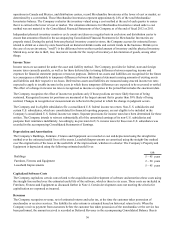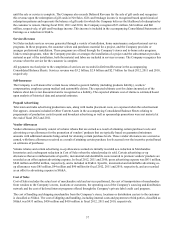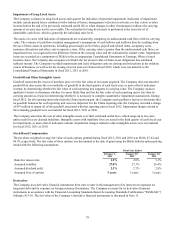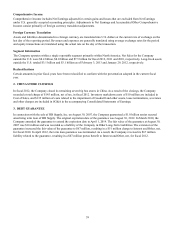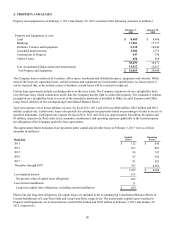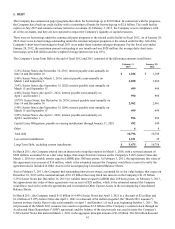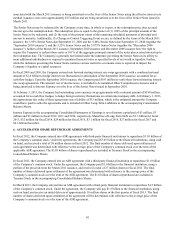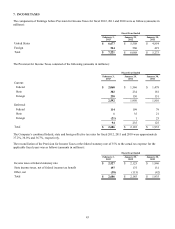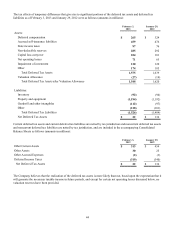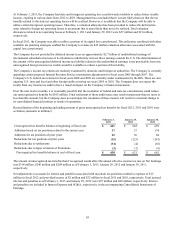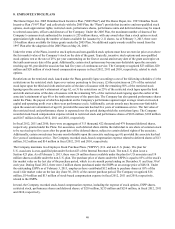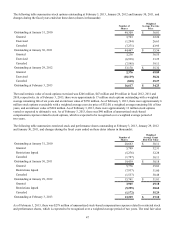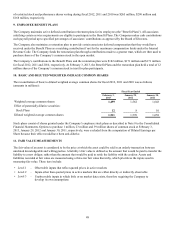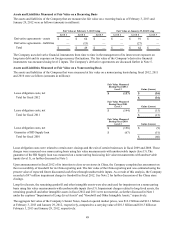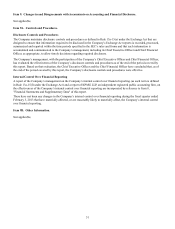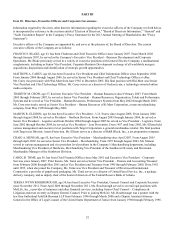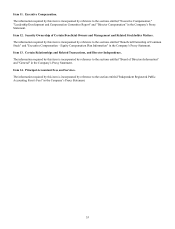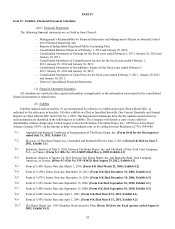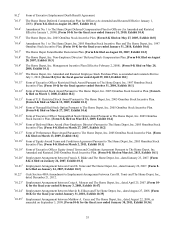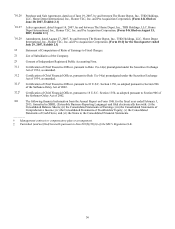Home Depot 2012 Annual Report Download - page 52
Download and view the complete annual report
Please find page 52 of the 2012 Home Depot annual report below. You can navigate through the pages in the report by either clicking on the pages listed below, or by using the keyword search tool below to find specific information within the annual report.
46
8. EMPLOYEE STOCK PLANS
The Home Depot, Inc. 2005 Omnibus Stock Incentive Plan ("2005 Plan") and The Home Depot, Inc. 1997 Omnibus Stock
Incentive Plan ("1997 Plan" and collectively with the 2005 Plan, the "Plans") provide that incentive and non-qualified stock
options, stock appreciation rights, restricted stock, performance shares, performance units and deferred shares may be issued
to selected associates, officers and directors of the Company. Under the 2005 Plan, the maximum number of shares of the
Company’s common stock authorized for issuance is 255 million shares, with any award other than a stock option or stock
appreciation right reducing the number of shares available for issuance by 2.11 shares. As of February 3, 2013, there were
154 million shares available for future grants under the 2005 Plan. No additional equity awards could be issued from the
1997 Plan after the adoption of the 2005 Plan on May 26, 2005.
Under the terms of the Plans, incentive stock options and non-qualified stock options must have an exercise price at or above
the fair market value of the Company’s stock on the date of the grant. Typically, incentive stock options and non-qualified
stock options vest at the rate of 25% per year commencing on the first or second anniversary date of the grant and expire on
the tenth anniversary date of the grant. Additionally, certain stock options may become non-forfeitable upon the associate
reaching age 60, provided the associate has had five years of continuous service. The Company recognized $23 million, $20
million and $20 million of stock-based compensation expense in fiscal 2012, 2011 and 2010, respectively, related to stock
options.
Restrictions on the restricted stock issued under the Plans generally lapse according to one of the following schedules: (1) the
restrictions on the restricted stock lapse over various periods up to five years, (2) the restrictions on 25% of the restricted
stock lapse upon the third and sixth anniversaries of the date of issuance with the remaining 50% of the restricted stock
lapsing upon the associate’s attainment of age 62, or (3) the restrictions on 25% of the restricted stock lapse upon the third
and sixth anniversaries of the date of issuance with the remaining 50% of the restricted stock lapsing upon the earlier of the
associate’s attainment of age 60 or the tenth anniversary of the grant date. The Company has also granted performance shares
under the Plans, the payout of which is dependent on the Company’s performance against target average return on invested
capital and operating profit over a three-year performance cycle. Additionally, certain awards may become non-forfeitable
upon the associate's attainment of age 60, provided the associate has had five years of continuous service. The fair value of
the restricted stock and performance shares is expensed over the period during which the restrictions lapse. The Company
recorded stock-based compensation expense related to restricted stock and performance shares of $166 million, $169 million
and $167 million in fiscal 2012, 2011 and 2010, respectively.
In fiscal 2012, 2011 and 2010, there were an aggregate of 313 thousand, 422 thousand and 479 thousand deferred shares,
respectively, granted under the Plans. For associates, each deferred share entitles the individual to one share of common stock
to be received up to five years after the grant date of the deferred shares, subject to certain deferral rights of the associate.
Additionally, certain awards may become non-forfeitable upon the associate reaching age 60, provided the associate has had
five years of continuous service. The Company recorded stock-based compensation expense related to deferred shares of $13
million, $12 million and $14 million in fiscal 2012, 2011 and 2010, respectively.
The Company maintains two Employee Stock Purchase Plans ("ESPPs") (U.S. and non-U.S. plans). The plan for
U.S. associates is a tax-qualified plan under Section 423 of the Internal Revenue Code. The non-U.S. plan is not a
Section 423 plan. As of February 3, 2013, there were 26 million shares available under the plan for U.S associates and 19
million shares available under the non-U.S. plan. The purchase price of shares under the ESPPs is equal to 85% of the stock’s
fair market value on the last day of the purchase period, which is a six-month period ending on December 31 and June 30 of
each year. During fiscal 2012, there were 2 million shares purchased under the ESPPs at an average price of $48.58. Under
the outstanding ESPPs as of February 3, 2013, employees have contributed $12 million to purchase shares at 85% of the
stock’s fair market value on the last day (June 30, 2013) of the current purchase period. The Company recognized $16
million, $14 million and $13 million of stock-based compensation expense in fiscal 2012, 2011 and 2010, respectively,
related to the ESPPs.
In total, the Company recorded stock-based compensation expense, including the expense of stock options, ESPP shares,
restricted stock, performance shares and deferred shares, of $218 million, $215 million and $214 million, in fiscal 2012, 2011
and 2010, respectively.


